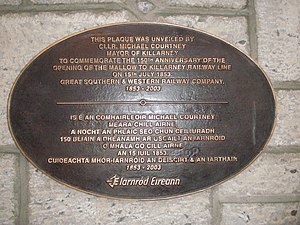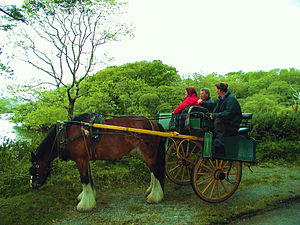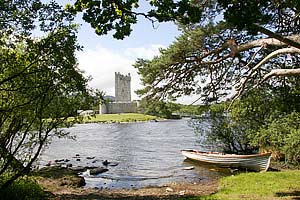Killarney
| Killarney Irish: Cill Airne | |
| County Kerry | |
|---|---|
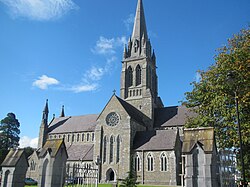 St Mary's Cathedral | |
| Location | |
| Grid reference: | V969909 |
| Location: | 52°3’32"N, 9°30’26"W |
| Data | |
| Population: | 14,219 (2011[1]) |
| Local Government | |
| Dáil constituency: |
Kerry |
| Website: | http://www.killarney.ie |
Killarney is a town in County Kerry, lying on the north-eastern shore of Lough Leane, part of Killarney National Park. It is home to St Mary's Cathedral, Ross Castle, Muckross House and Abbey, the Lakes of Killarney, MacGillycuddy's Reeks, Purple Mountain, Mangerton Mountain, the Gap of Dunloe and Torc Waterfall. Its natural heritage, history and location on the Ring of Kerry make Killarney a popular tourist destination.[2] Its name is from the Irish Cill Airne, meaning "church of sloes".
Killarney won the Best Kept Town award in 2007, in a competition jointly organised by the Department of the Environment and the Northern Ireland Amenity Council. In 2011, it was named Ireland's tidiest town and the cleanest town in the country by Irish Business Against Litter.[3]
Contents
History
Killarney has featured prominently in early Irish history, with religious settlements playing an important part of its recorded history. Its first significantly historical settlement was the monastery on nearby Innisfallen Island founded in 640 by St Finian the Leper,[4] which was occupied for approximately 850 years.
Innisfallen or Inishfallen (from Irish: Inis Faithlinn, meaning "Faithlinn's island") is an island in Lough Leane; one of the three Lakes of Killarney in County Kerry, Ireland. It is home to the ruins of Innisfallen Abbey, one of the most impressive archaeological remains dating from the early Christian period found in the Killarney National Park. The monastery was founded in 640 by St. Finian the Leper, and was occupied for approximately 850 years. Over a period of about 300 of these, the monks wrote the Annals of Innisfallen, which chronicle the early history of Ireland as it was known to the monks. The monks were dispossessed of the abbey on 18 August 1594, by Elizabeth I.
The location of the monastery on the island is thought to have given rise to the name Lough Leane (Irish Loch Léin), which in English means "Lake of Learning". According to tradition the Irish High King Brian Boru received his education at Innisfallen under Maelsuthain O'Carroll. Maelsuthain has been credited as the possible originator of the Annals.
It is possible for tourists to visit the island during the summer months, with boats leaving from Ross Castle throughout the day.
Aghadoe, the local townland which overlooks present day Killarney, may have begun as a pagan religious site.[5] The site has also been associated with the 5th century missionary St Abban, but 7th-century ogham stones mark the first clear evidence of Aghadoe being used as an important site.[6] According to legend, St Finian founded a monastery at Aghadoe in the 6th or 7th century. The first written record of a monastery dates from 939 AD in the Annals of Innisfallen where the Aghadoe monastery is referred to as the "Old Abbey."[6]
Following the Anglo-Norman invasion of Ireland in 1169, the Normans built Parkavonear Castle, also at Aghadoe. The castle was perhaps intended as an early warning outpost due to its views of the entire Killarney valley and lakes region.
Ross Castle was built on the lake shore in the late 15th century by local ruling clan the O'Donoghues Mor (Ross). Ownership of the castle changed hands during the Desmond Rebellions of the 1580s to the Mac Carty Mor.
Muckross Abbey was founded in 1448 as a Franciscan friary for the Observantine Franciscans by Donal McCarthy Mor. The abbey was burned down by Cromwellian forces under General Ludlow in 1654, and today remains a ruin.
History of tourism
Killarney's tourism history goes back at least to the mid 18th century, when Thomas Browne, 4th Viscount Kenmare (Lord Kenmare), began to attract visitors and new residents to the town. The date of 1747 was used in recent 250-year celebrations to honour the history of Killarney tourism. A visit by Queen Victoria in 1861 gave the town some international exposure.
Killarney benefited greatly from the coming of the railway in July 1853. British trade directory publisher Isaac Slater noted that there were three hotels in the town in 1846[7] but by 1854, one year after the coming of the railway, James Fraser named seven hotels and described their locations:the Railway Hotel opposite the Railway Station; the Kenmare Arms and Hibernia which are on the main street and immediately opposite the church... the Victoria which is about a mile to the west of the town on the shores of the Lower Lake; the Lake View which is about the same distance to the east of the town and also on the shore of the Lower Lake; the Muckross about two and a half miles away and near the Muckross Lake and the Torc which occupies an elevated site about a mile and a half from the town on the hill which rises immediately over the Lake Hotel.[8]
In 1858, Irish born Victorian journalist, Samuel Carter Hall named O'Sullivan's Hotel and the Innisfallen rather than the Hibernia and Torc, but Isaac Slater also named the Hibernia in 1846. At the time he was writing, tours of the Ring of Kerry were already an industry and Killarney was considered the starting point of the hundred and ten mile circuitous route. He was fascinated by the horses' endurance on the two-day trip, and leaves clear advice for other travellers;
It is a common and wise custom of those who make this tour, and are not pressed for time, to hire the carriage at the hotel in Killarney and continue with it 'all the way round.' It is absolutely marvellous what these mountain bred horses can get through "thinking nothing" of thirty miles for days together or even fifty miles in a single day.[9]
As part of the trip, he noted that there were hotels in Glenbeigh and Waterville along with a "comfortable inn", which is now The Butler Arms Hotel.
Transport
Road
Killarney is served by National Primary Route N22 (north to Tralee and Castleisland and east to Cork); the National Secondary Routes N72 (west to Killorglin) and the N71 (south to Bantry).
Rail
Killarney railway station has direct services to Tralee, Cork and Dublin, with connections to the rest of the rail network.
Bus
Bus services are provided to Limerick (and onwards to Dublin), Tralee, Cork, Kenmare and Skibbereen.
Air
Kerry Airport (10 miles), in Farranfore between Tralee and Killarney, provides an increasing number of air services with connecting trains running from Farranfore railway station to Killarney railway station. Cork Airport (55 miles), easily accessible by bus or rail, also serves the Kerry region.
Sport
Football
Killarney has three association football clubs—all of which compete in the Kerry District League: Killarney Athletic, founded in 1965; Killarney Celtic, founded in 1976; and Cedar Galaxy was formed in 2011.
Cycling
The Ring of Kerry Cycle, a charity cycle around the Ring (108 miles) takes place every first Saturday in July. In recent years the numbers taking part have risen to 12,000 and the event has raised millions for local charities. There is also a club in Killarney called Killarney Cycling Club and is very successful in Road and Mountain Biking. The club has a strong youth side and adult side and competes regularly. The club had a team in the An Post Rás in 2014 and features every year in the Rás Mumhan. On the mountain biking side, they had a national championship winner in the youth and adults.
In 2011 Killarney was due to a host a round of the UCI Mountain Bike European Championships but unfortunately the construction of the venue never started due to complications. Construction of the proposed €430,000 trail which is a joint initiative between Kerry County Council, Cycling Ireland and local landowner Mr Con O’Donoghue was then pushed back to December 2012, as of December 2015 no construction has started and the original planning permission has expired. The fate of the project is unknown.
Gaelic games
Killarney has three Gaelic football teams: Dr Crokes, Killarney Legion and Spa. The rural hinterland has a large number of football teams, such as Kilcummin, Fossa, Firies, Glenflesk and Gneeveguilla. All these teams compete in the Kerry County league and the East Kerry Senior Football Championship (O'Donoghue Cup) and league.
Rowing
There are six active rowing clubs in the town, who share a common history in Ireland's oldest surviving regatta, the Killarney Regatta, which is held annually on the first or second Sunday in July. The six clubs are Commercial RC (Killarney), Flesk Valley RC, Fossa RC, Muckross RC, St. Brendan's RC and Workmen RC. The style of rowing seen at the regatta is traditional, fixed seat rowing in wide, wooden six-person boats. Since the eighties, a number of the clubs have moved toward coastal type rowing and modern 'slide' or Olympic style rowing.
Rugby
Killarney RFC play in the Munster Junior League. The club has also a large youth and underage set-up catering for all young enthusiasts from the town and surrounding areas.
Judo
Killarney Judo Club has been active in Killarney since the late 1960s. The club has had numerous All Ireland winners in its history along with international competition winners. The club caters to people from the town and surrounding areas for everyone over the age of 6.
Golf
Killarney Golf & Fishing Club attracts various national competitions such as the Irish Open. The Ross Golf Course is a 9-hole golf course less than one mile from the centre of the town.
Horse racing
Killarney Racecourse is located just outside the town and holds flat and national hunt meetings.
Killarney in song
At the beginning of the 20th century, when music-hall songs in Britain about "Good Old Ireland" were all the rage, a number of these songs included reference to Killarney, notably "My Father Was Born In Killarney - Don’t Run Down The Irish" (1910), "Too Ra Loo Ra Loo Ral" (1914), "For Killarney and you" (1916), "My little cottage home in sweet Killarney" (1917), "Oh my Lily of Killarney" (1917).
"There's Only the One Killarney" is a song that was written by Dick Farrelly and recorded by Patrich O'Hagan. Killarney also appears in "How Can You Buy Killarney," written by Kennedy, Steels, Grant and Morrison, and recorded by Joseph Locke, among others. Killarney is also mentioned in "Christmas in Killarney" (written by Redmond, Cavanaugh and Weldon) and "Did Your Mother Come From Ireland?" (written by Kennedy and Carr), both most notably recorded by Bing Crosby. "Some Say the Devil Is Dead" by Derek Warfield contains the line "Some say the devil is dead and buried in Killarney/ More say he rose again and joined the British Army."[10] In the chorus of Celtic rock band, Gaelic Storm's, song Raised on Black and Tans, the singer declares his Irish heritage by saying "my mother’s brother’s sister’s cousin’s auntie’s Uncle Barney’s father’s brother had a cousin from Killarney."
In James Joyce's story "A Mother", one of the entrants at a singing competition sings a song about Killarney.
Industry
Lord Kenmare founded linen mills in the 1740s as part of his efforts to increase the population and economy of Killarney.
Hosiery manufacturing and shoe making were major industries in the town during the 20th century but have since seen decline.
Liebherr Cranes have had a presence in Killarney since 1958, with a combined manufacturing/research and development facility in the town manufacturing container cranes. In honour of its founder, a street was named Dr Hans Liebherr Road.
Tricel formally known as Killarney Plastics was started in 1973 by Anne & Con Stack. This successful multinational has operations in five countries and employs 300 people. Dollinger-SPX, a filtration products firm, have production facilities in the local IDA Industrial Estate. Indigenous firms such as Torc Engineering and National Organic Products have established small industries in Killarney.
Monex Financial Services operate a facility specialising in the processing of Credit Card Payments worldwide at Killarney Technology Park.
Muckross Pottery and Muckross Weavers based beside Muckross House have a small tableware and woolens business aimed at the tourist market, a neighbouring bookbinding facility carries out book and manuscript restoration and binds high quality books for universities, publishers and libraries.
Kerry Woolen Mills is a family firm that manufactures hats, gloves, sweaters, women's fashion, blankets, scarfs and stockings at their premises near Beaufort.
The Department of Arts, Sport and Tourism have also moved to Killarney, a key beneficiary of the decentralisation of Civil Service departments outside of Dublin. Certain sections of the Department of Justice have been situated in Killarney for a number of years.
Tourism
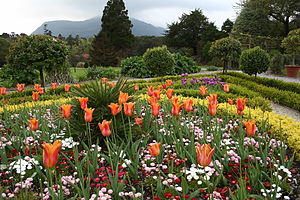
Tourism is by far the largest industry in Killarney. With the exception of Dublin, there are more hotel beds in Killarney than in any other Irish town or city. The tourist population is increasingly diverse, but most of the tourists come from the US, Ireland, the UK, Germany and other European countries.
In the summer months, Killarney is busy with tourists visiting the town's numerous shops and tourist attractions. Many shops are tourist-oriented, with many gift shops around the town. The town centre also offers a wide range of hotels, pubs and restaurants. Killarney is famous for its jaunting cars (horse-drawn carts) operated by local jarvies.
Sporting events during the festival included the Ring of Kerry Charity Cycle, the Killarney Regatta, the 5 km SummerFest Fun Run and the Killarney Races.
Conference and events
The INEC (Ireland's National Events Centre) Killarney convention centre has a capacity of 2,500 and has hosted many major conferences and events since its opening in 2001. Google, IBM, GSK have used the centre for major events. The venue has also hosted major sporting events, incl Tae-Kwon-Do, snooker, boxing, and concerts with major national and internationally renowned artists including Willie Nelson, Cliff Richard, The Script, Snow Patrol, Bob Geldof, Billy Connolly, Kenny Rogers, and José Carreras.
Nightlife
Killarney is a popular destination for party goers. Killarney's nightspots are often busy seven days a week during the summer months and weekend throughout the year when the population of the town and the surrounding area increases significantly. The INEC hosts major National and International artists.
Car rallying
Until the early 1980s, Killarney was the destination of the Circuit of Ireland Rally, which was held every year over the Easter holiday weekend. Nowadays, on the first weekend of May each year, the town plays host to the International Rally of the Lakes.
References
- ↑ "Killarney Legal Town Results". Central Statistics Office. 2011. http://census.cso.ie/sapmap2011/Results.aspx?Geog_Type=ST&Geog_Code=19011.
- ↑ "Best Destinations in Ireland - Travellers' Choice Awards - TripAdvisor". tripadvisor.ie. http://www.tripadvisor.ie/TravelersChoice-Destinations-cTop-g186591.
- ↑ "Killarney named Ireland's tidiest town". RTÉ News. 5 September 2011. http://www.rte.ie/news/2011/0905/tidytowns.html. Retrieved 2011-09-05.
- ↑ "Saint Finian, surnamed Lobhar, or the Leper. March 16. Rev. Alban Butler. 1866. Volume III: March. The Lives of the Saints". Bartleby.com. http://www.bartleby.com/210/3/162.html. Retrieved 2012-05-01.
- ↑ Long, Tom. "Tracing Our Faith." Fossa & Aghadoe: Our Heritage and History. ed. Jim Larner. Fossa Historical Society. 2007. ISBN 978-0-9557739-0-7. p 1.
- ↑ 6.0 6.1 Long, 1.
- ↑ Slater, Isaac. Slater's Directory. 1846.
- ↑ Fraser, James. Guide to Killarney. 1854
- ↑ Hall, Carter. A Week in Killarney. 1858
- ↑ "Some Say The Devil Is Dead". Kinglaoghaire.com. 25 May 1944. http://www.kinglaoghaire.com/site/lyrics/song_397.html. Retrieved 2012-05-24.
| ("Wikimedia Commons" has material about Killarney) |
